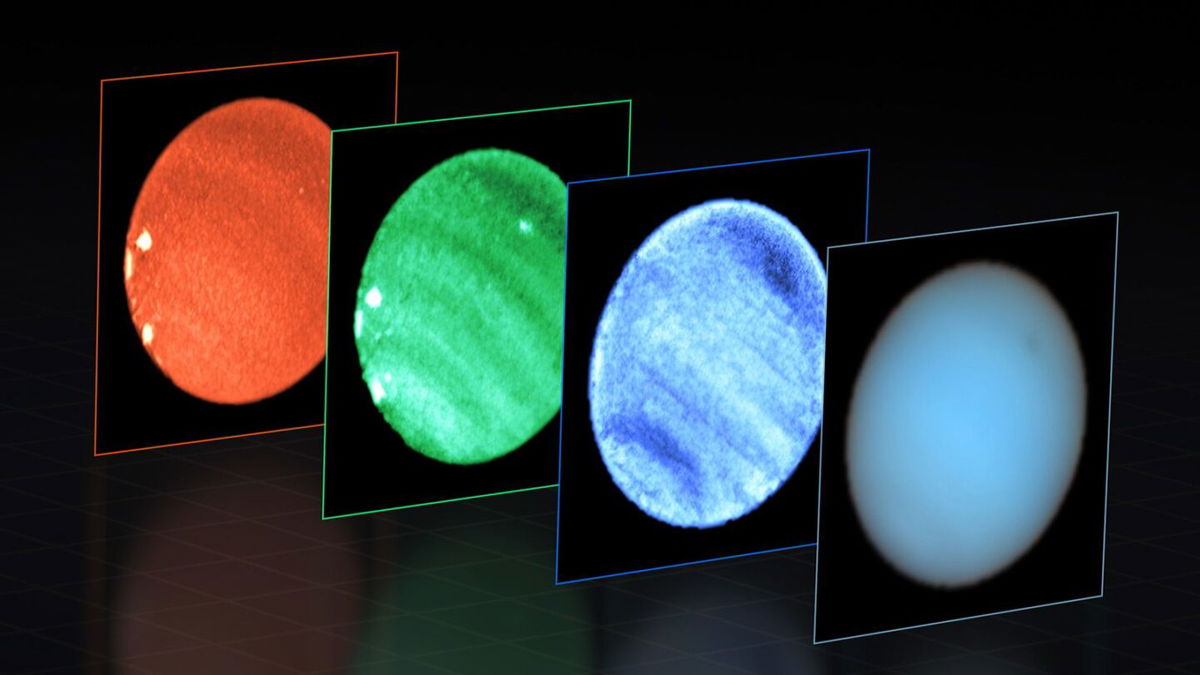Mysterious dark spot detected on Neptune

By Ashley Strickland, CNN
(CNN) — Astronomers have spotted a large and mysterious dark spot within Neptune’s atmosphere, and it has an unexpectedly bright companion.
The observation was made using the European Southern Observatory’s Very Large Telescope in Chile.
Space-based observatories such as the Hubble Space Telescope have observed vortex-like storms — which appear as dark spots — swirling in the blue planet’s atmosphere before, but it’s the first time an Earth-based telescope has seen one on Neptune.
These new observations are shedding more light on the phenomenon, according to new research published Thursday in the journal Nature Astronomy.
“Since the first discovery of a dark spot, I’ve always wondered what these short-lived and elusive dark features are,” said lead study author Patrick Irwin, professor of planetary physics at the University of Oxford, in a statement.
Gas giants and dark spots
Giant gaseous planets in our solar system, including Neptune, are known for the dark spots that appear in their atmospheres, such as Jupiter’s Great Red Spot, a centuries-old storm.
Neptune, an ice giant, has had multiple storms observed by Hubble over the years. The storms all seem to follow a pattern of appearing and disappearing over the course of two years, making them difficult to study. Voyager 2, a NASA probe launched in the 1970s, also glimpsed two dark storms on Neptune during its 1989 flyby of the planet, but those disappeared well before Hubble could observe them when it captured images of Neptune in 1994. The Great Dark Spot on Neptune, the nickname given to the largest storm witnessed by Voyager 2, was so large that it could contain Earth.
Neptune’s storms behave differently than hurricanes on Earth. The dark spots are high-pressure systems that start out stable and rotate clockwise, while hurricanes in Earth’s Northern Hemisphere are low-pressure systems that rotate counterclockwise.
What Irwin and his team sought to find out is how these massive storms on Neptune form in the first place.
Newly discovered Neptune feature
Neptune, which has a blue hue due to the methane in its atmosphere, is a frozen world with an average temperature of minus 392 degrees Fahrenheit (minus 235 degrees Celsius) and screaming winds that send frozen methane clouds across the planet at 1,200 miles per hour (1,931 kilometers per hour). It’s the most distant planet in our solar system, about 30 times father from the sun than Earth is, and this distance makes noon on Neptune look like twilight on Earth.
When Hubble discovered new dark spots on Neptune in 2018, Irwin’s team seized its chance to conduct Earth-based observations with the Very Large Telescope and its Multi Unit Spectroscopic Explorer instrument, or MUSE. The instrument allows astronomers to observe the entirety of an astronomical object all at once in different wavelengths of light, according to the European Southern Observatory.
Earth’s atmosphere tends to create a distorting effect for ground-based telescopes, but MUSE relies on a technique called adaptive optics to capture sharp images. The telescope’s mirrors, controlled by computers, can make real-time adjustments that correct any distortions caused by Earth’s atmosphere and preserve the fine details of celestial objects.
Data captured by the Very Large Telescope helped astronomers determine that the dark spots aren’t caused by gaps, or a clearing, in the clouds. Instead, the observations suggest that spots appear as darkening air particles gather beneath Neptune’s prominent atmospheric layer, where haze and ice mix together.
The MUSE instrument captured a 3D spectrum of light for Neptune and its dark spot, allowing astronomers to study the storm in detail and even make a surprise observation.
“In the process we discovered a rare deep bright cloud type that had never been identified before, even from space,” said study coauthor Michael Wong, a planetary scientist at the University of California, Berkeley, in a statement.
The unusual cloud appeared in the observation as a smaller bright spot next to the larger dark spot, and both are on the same atmospheric level. The astronomers said they are intrigued by the newly discovered feature and hope to learn more with future observations that can be conducted from Earth.
“This is an astounding increase in humanity’s ability to observe the cosmos,” Wong said. “At first, we could only detect these spots by sending a spacecraft there, like Voyager. Then we gained the ability to make them out remotely with Hubble. Finally, technology has advanced to enable this from the ground.”
The-CNN-Wire
™ & © 2023 Cable News Network, Inc., a Warner Bros. Discovery Company. All rights reserved.






